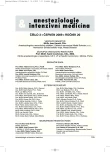-
Medical journals
- Career
Catheter-related blood stream infections
Authors: Bureš Jan; Beroušek Jan; Cvachovec Karel
Authors‘ workplace: Klinika anesteziologie a resuscitace UK 2. LF a IPVZ, Fakultní nemocnice v Motole, Praha
Published in: Anest. intenziv. Med., 20, 2009, č. 3, s. 149-152
Category: Intensive Care Medicine - Original Paper
Overview
Objective:
To evaluate the occurrence of catheter related blood stream infections in the critical care department when using antimicrobial coated central venous catheters.Design:
Cross-sectional study.Setting:
Critical care unit, Department of Anaesthesiology and Intensive Care Medicine University Hospital.Material and method:
During the period 1. 4. 2007–31. 12. 2007 we monitored number of inserted catheters, duration of insertion and bacterial colonisation from the catheter tips and hemocultures.Results:
Overall number of inserted catheters was 270, mean insertion time was 7.5 days, 16 catheters (5.9%) were colonised, match with the hemocultures in 1 case (0.4%). This corresponds to 0.5/1000 catheter-day.Conclusion:
Compared to results in reference studies, our findings show higher rate of colonisation where as the percent occurrence is lower. Our results correspond to findings published in larger studies.Keywords:
central venous catheters – CRBSI – infection – prevention – chlorhexidine – intensive care
Sources
1. Veenstra, D. et al. Cost - effectiveness of antiseptic-impregnated central venous catheters for prevention of catheter related blood stream infections. JAMA, 1999, 282, p. 554–560.
2. Maki, D. G., Weise, C. E., Sarafin, H. W. A semiquantitative culture method for identifying intravenous-catheter-related infection. N. Engl. J. Med., 1977, 296, 23, p. 1305–1309.
3. Sheretz, R. J., Raad, I. I., Belani, A. et al. Three–year experience with sonicated vascular catheter cultures in a clinical microbiology laboratory. J. Clin. Mikrobiol., 1990, 28, p. 76–82.
4. Veenstra, D. L., Saint, S., Saha, S. et al. Efficacy of antiseptic impregnated central venous catheters in preventing catheter-related blood stream infections. A meta-analysis. JAMA, 1999, 281, p. 261–267.
5. Timsit, J. F. Diagnosis and prevention of catheter-related infections. Curr. Opin. Care, 2007, 13, p. 563–571.
6. Chaiyakunapruk, N., Veenstra, D. L. et al. Chlorhexidine compared with povidine-iodine solution for vascular catheter-site care: A meta-analysis. Ann. Intern. Med., 2002, 136, p. 792–801.
7. Ho, M. K., Litton, E. Use of chlorhexidine-impregnated dressing to prevent vascular and epidural catheter colonization and infection: a meta-analysis. J. Antimicrob. Chemother., 2006, 58, p. 281–287.
8. Byrnes, M., Coopersmith, C. Prevention of catheter related blood stream infections. Curr. Opin. Crit. Care, 2007, 13, p. 411–415.
9. McGee, D. C., Gould, M. K. Preventing complications of central venous catheterization. NEMJ, 2003, 348, p. 1123–1133.
10. Maki, D. G., Kluger, D. M., Crnich, Ch. The risk of bloodstream infection in adults with different intravascular devices: A systematic review of 200 published prospective studies. Mayo Clin. Proc., 2006, 81, 9, p. 1159–1171.
11. Bach, A., Schmidt, H., Bötteger, B. et al. Retention of antibacterial activity and bacterial colonization of antiseptic-bonded central venous catheters. J. Antimicrob. Chemother., 1997, 37, p. 315–322.
12. Maki, D. G., Stolz, S. M., Wheeler, S., Mermel, L. A. Prevention of central venous catheter-related bloodstream infection by use of an antiseptic impregnated catheter. A randomized, controlled trial. Ann. Int. Med., 1997, 127, p. 257–266.
13. Rupp, M. E., Lisco, S. J., Lipsett, P. A. et al. Effect of a second-generation venous catheter impregnated with chlorhexidine and silver sulfadiazine on central catheter-related infection. A randomized, controlled trial. Ann. Intern. Med., 2005, 143, p. 570–580.
14. Carrasco, M. N., Bueno, A. et al. Evaluation of a triple-lumen central venous heparin-coated catheter versus a catheter coated with chlorhexidine and silver sulfadiazine in critically ill patients. Int. Care Med., 2004, 30, p. 633–638.
Labels
Anaesthesiology, Resuscitation and Inten Intensive Care Medicine
Article was published inAnaesthesiology and Intensive Care Medicine

2009 Issue 3-
All articles in this issue
- Analgosedation in Intensive Care Units (ICU) in the Czech Republic – the results of questionnaire study
- Dynamic parameters of preload in pressure support ventilation
- Regional cooling of blood in the extracorporeal circuit: New way of anticoagulation during CRRT
- Catheter-related blood stream infections
- Blood and tissue glucose level in critically ill patients: Comparison of different methods of measuring interstitial glucose levels
- Delirium during the postoperative period and in the intensive medicine
- Polarography – major contribution of Jaroslav Heyrovský to the intensive therapy
- Dr. Zdeněk Křivánek: Krivanek’s Anaesteshesiologist Biannual Meeting in Pardubice
- Anaesthesiology and Intensive Care Medicine
- Journal archive
- Current issue
- Online only
- About the journal
Most read in this issue- Analgosedation in Intensive Care Units (ICU) in the Czech Republic – the results of questionnaire study
- Delirium during the postoperative period and in the intensive medicine
- Catheter-related blood stream infections
- Dynamic parameters of preload in pressure support ventilation
Login#ADS_BOTTOM_SCRIPTS#Forgotten passwordEnter the email address that you registered with. We will send you instructions on how to set a new password.
- Career

